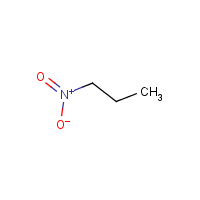1-Nitropropane
Agent Name
1-Nitropropane
CAS Number
108-03-2
Formula
C3-H7-N-O2
Major Category
Nitrogen Compounds

Synonyms
1-NP; 1-Nitropropane; [ChemIDplus] UN2608
Category
Nitros, Aliphatic
Description
Colorless liquid with a somewhat disagreeable odor; [NIOSH]
Sources/Uses
Used in organic chemical synthesis and as a rocket propellant, gasoline additive, and solvent; [ACGIH] Used as a solvent for waxes, resins, lacquers, synthetic rubber, fats, oils, dyes, inks, and other organic materials; [HSDB]
Comments
A hepatotoxin in animals after oral administration or inhalation; [ACGIH] An eye and respiratory tract irritant; [ICSC] Volunteers tolerated 100 ppm for 8 hours; 150 ppm caused irritation of the nose and throat; A weak inducer of methemoglobinemia; [CHEMINFO] Causes CNS depression and anesthesia in lethal concentration animal studies; [ChemIDplus] See "2-Nitropropane."
Biomedical References
Exposure Assessment
Skin Designation (ACGIH)
Insufficient data
TLV (ACGIH)
25 ppm
PEL (OSHA)
25 ppm
MAK
2 ppm
IDLH (NIOSH)
1000 ppm
Excerpts from Documentation for IDLHs
Other animal data: It has been reported that rabbits survived a 1hour exposure to 10,000 ppm [Machle et al. 1940]. Human data: Volunteers found brief exposures to concentrations exceeding 100 ppm to cause eye irritation [Silverman et al. 1946].
Vapor Pressure
10.1 mm Hg
Odor Threshold Low
7.7 ppm
Odor Threshold High
140 ppm
Lethal Concentration
LC50 (rat) = 3,100 ppm/8H
Explanatory Notes
Detection odor threshold from AIHA (mean = 140 ppm); Flash point = 36 deg C; VP from HSDB;
NFPA
may ignite at ambient temp
Adverse Effects
Methemoglobinemia
MetHgb is secondary toxic effect
Neurotoxin
Other CNS neurotoxin
Hepatotoxin
Hepatoxic (a) from occupational exposure (secondary effect) or (b) in animal studies or in humans after ingestion
ACGIH Carcinogen
Not Classifiable
Diseases, Processes, and Activities Linked to This Agent
Processes
Industrial Processes with risk of exposure: